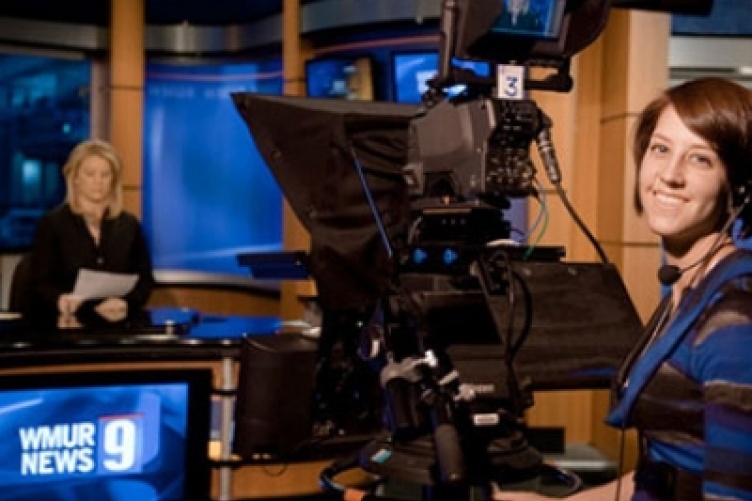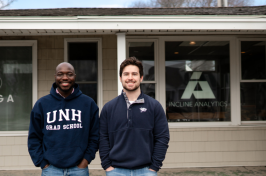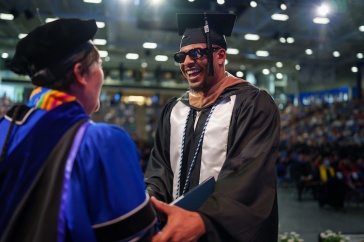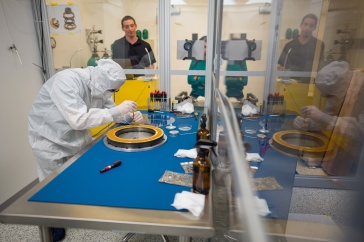
Whether it’s creating their own website or recording a short video for class on their smartphones, today’s students are looking for ways to integrate technology into their studies. University of New Hampshire at Manchester faculty members have seen the increased use of digital technology in a wide range of fields and are responding by adding digital elements to their classes.
Communications Arts is one such program. With two new options focused on getting technology into students’ hands, as well as a new and expanded audio and video studio in the 88 Commercial Street building, UNH Manchester students now have more access than ever to the technology being used in the media and communications industries today.
Beginning this year, Communication Arts students can enroll in two new “options,” allowing them to take five classes specifically focused on the digital, film and audio side of communications. The options also show up on students transcripts and better describe to graduate schools and future employers the student’s expertise, said Associate Professor of Communications Jeffrey Klenotic.
“Alumni already describe what they did at UNH Manchester,” Klenotic said. “They got a major in Communication Arts, but on LinkedIn, they’re talking about studying digital media.” Digital media is for students who want to go into corporate communications at a large company that does its own website work or video production. “They have a good skill set to start their own company,” said Klenotic.
What makes this option unique from the others is the mix of Communication Arts classes and Computing Technology classes. “Digital media is a major growth area in terms of the job market and student interest,” said Associate Professor of Communications Anthony Tenczar. “We wanted courses like web design and mobile media, a collection of courses that were essential to students who wanted to work in the digital field.”
Cinema & Media Arts is bringing the Communication Arts program’s ample classes in audio and video technology into one option for students passionate about film production and a career in the television and film industry. Courses will include media aesthetics and film history, screenwriting, audio production and video production.
Although this option wasn’t available when she was in school, UNH Manchester Communications Arts alumna Mollie Markins took many of the classes that are now offered as part of the Cinema & Media Arts option, including Film History and a number of production classes. She also did two video production internships – at Manchester Public TV and at WMUR Channel 9. Mollie is now working in the Marketing Department of the Granite United Way using her skills to produce video for the non-profit, and is running her own video production company, Markins Media. “I started Markins Media the summer immediately following graduation in May 2013 when I realized I didn’t need to live in California or NY to make a name for myself in the production industry,” said Markins.
Mike Avitabile, another UNH Manchester Communication Arts alum, started his career at a TV station in Santa Monica, Calif., worked to help launch Hulu at NBC and today is a novelist and director of content operations at Sony Network Entertainment. “My time at UNH Manchester was kind of two-fold,” said Avitabible. “I have this production background. … It’s what got me going at my career at NBC. On the other side I was writing. (Professor) Barbara Jago was really instrumental in me realizing this was something I should be doing gave me lots of positive feedback on my writing.”
Hands-on experience is something students who study film, production or digital media want to get as much of as possible. UNH Manchester Communication Arts students can now do so in the new audio and video studio.
Working with the mill building’s unique space, professors Tenczar and others created a large studio that will allow students to record voice overs and small bands, film in front of a green screen, conduct on-camera interviews and do all of their editing and special effects.
The space was designed to allow for future growth in the coming years, as technology develops. The audio and video recording studios are adjacent, allowing students to do ambitious projects, said Tenczar. “The whole idea of the studio design is to give students maximum flexibility as to what they want to do,” said Tenczar.
-
Written By:
Beth LaMontagne Hall | Freelancer
















































